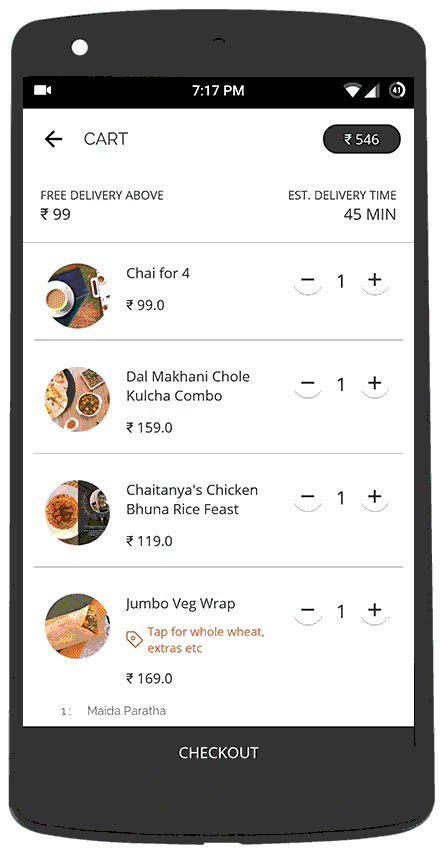
Photo credit: wavebreakmediamicro / 123RF.
If everything goes according to plan, Chaitra Chidanand and Nitya Sharma’s Simpl will create a credit system that is unlike anything the world has seen before.
Here is the plan.
Let’s say you decide to buy something from popular Indian food delivery startup FreshMenu. When you get to checkout, you can choose to “Pay later with Simpl.” Your bill is immediately subtracted from the credit limit that Simpl has provided you for the month. You’ll have to clear that bill every 1st and 16th.
Your Simpl account is linked to your phone number. The more you buy and the more responsible you are, the bigger your loan size gets. If you link your Facebook to your Simpl, your loan size increases. Link information from India’s new biometric identification system, Aaadhar, and you might increase your loan size some more.
Credit doesn’t roll over. If you haven’t paid off the previous fortnight, you aren’t eligible for a new one. That means that there are no interest rates.

The credit you’ve taken out from Simpl is powered by an NBFC – a non-banking financial company – which is the only entity outside of a bank that India’s central bank, the Reserve Bank of India, has given permission to lend money.
As of now, Simpl can only be used by customers that merchants have approved. That approval will be something like – the more often you use FreshMenu, the more likely you are to get offered an invite to Simpl, and the higher your loan size.
“What we believe will happen is a giant leapfrog of the credit card itself,” Chaitra says concisely.
It’s not hard to understand why I needed a strong cup of coffee before starting our conversation.
How it all works
Simpl sits right at the point of sale, where a customer completes their transaction. That spot is a heavily contested battleground. There, the company needs to prove that it’s better to take out a small loan than it is to pay using an e-wallet, or with a bank account, or by cash.
Simpl has raised funding from US-based Green Visor Capital, IA Ventures, and a few angel investors.
The team’s strategy is to make Simpl the easiest and fastest to use among all of those options. “We’re the ones making the one-click checkout possible,” explains Chaitra. “Forty percent of transactions via credit card fail using a mobile device. With Simpl, only one percent does. We do all of our authentications in the backend, because numbers and alphabets and whatnot shouldn’t interfere with a customer’s experience of paying. It’s fast and seamless.”
The duo also believes that it’s an answer for customers that like to pay with cash. “45 percent of customers prefer to use cash on delivery. We all know that’s a big friction point,” she says. “But since it takes so little time to check out, more people will start using digital payments.”
Simpl’s app is also easy to use. Credit is displayed in a circle, with the amount you have left decreasing as you spend it. Users can pay off loans with their bank accounts. Chaitra also mentions the possibility of working with the United Payments Interface (UPI), a new technology released by the RBI that lets people transfer money from bank-to-bank and bank-to-merchant with a single identifier, like an Aadhar fingerprint or a registered virtual address.
For merchants, onboarding Simpl requires integration of Simpl’s SDK (software development kit). From there, the company operates on a series of APIs (application programming interface) that let it remain lightweight.
End-to-end credit system
Conventional credit systems, like CIBIL in India, have wide wingspans but still manage to miss a lot of people. Those like the economically disadvantaged or recent immigrants have limited data available on them, which means it’s hard to figure out if they’re trustworthy enough to lend money to.
One solution is to give out smaller loans. They can help build out a credit history in a way that’s not as risky – for both the lender and the borrower – as taking out a major loan.
This can be done by taking into consideration the millions of data points collected daily from people interacting online. Some, like InVenture, crunch data points from social networks and mobile usage to help create credit scores and lend money.
Simpl’s focus on the exact point where merchants and customers interact online is what makes it slightly different. “For the first time in generations, we have a convergence of merchants, customers, and payments,” Chaitra says. “This is like what the doodhwala (milk-seller) relationship was like years ago. He’d show up at your door and you could pay later because he trusted you. We’re there again, where reputation can again be your biggest asset.”
The duo’s vision for crediting is centered around the smartphone. “We’d make your entire phone your credit card,” Nitya envisions. “It would capture information, data underwriting, it would safeguard individuals against fraud, it would let you block transactions.”
Credit is your friend
What’s also refreshing is their focus on making credit more accessible and useful.
“We’re not predatory,” Chaitra says. “There are no late fees and we aren’t being mean to customers. It’s a whole new type of lending.”
“Right now, we can distribute a credit card equivalent to 220 million people,” she adds. “Can you possibly do that with physical cards?”
It may need the backing of a major merchant to really take off.
Since loans are generally small, Simpl takes the risk of covering interest rates and people who never pay back loans. “Really, the first time is the riskiest loan,” Chaitra says. “That initial amount we lend out is the toughest. After that, we start to know whether someone is trustworthy.” If the sum is big enough, those who don’t pay back are chased with penalties.
For the NBFC that has paired with Simpl, the exciting part is that it has access to millions of new, de-risked customers that it otherwise wouldn’t have been able to lend to.
Moving credit around a bit
While Simpl’s smooth user experience and focus on simple credit are necessary, the most important factor in its success can arguably be narrowed down to one thing: whether or not merchants find it useful to sign up with Simpl.
As of now, it’s only onboarded a handful of merchants, including FreshMenu, Faasos, and Nykaa. “We started with foodtech because of how repetitive consumption there is,” Nitya says.
The app prompts customers to a screen where they can request different merchants to sign on with Simpl by tweeting at them. Popular requests include Swiggy, Uber, and Amazon India.
It may be the backing of one of these major merchants that will help Simpl take off. Paytm, for example, gained the majority of its initial traction when Uber India began accepting payments for the e-wallet into its app.
“We have perks for merchants like faster refunds than what any other e-wallet or bank can do,” says Chaitra. Those refunds are instantaneous because Simpl operates on a stack of APIs that track each moment of a transaction. When a payment needs to be reversed, the team can do it instantly. It also guarantees that a refund will be placed back in a customer’s account – since all Simpl really needs to do is move credit around a bit.
“It’s also a way to give your most loyal customers rewards,” adds Chaitra.
Outside of those like e-wallets that compete at the point-of-sale, there are a few others with similar ideas. The recently Naspers-acquired CitrusPay is working on a similar pay-later service called LazyPay. The company now belongs to PayU, which claims to service over 150 million customers after the acquisition. That means that LazyPay will come integrated for any merchant that’s using a PayU gateway. Unlike Simpl, it’s more of a bill that you pay at the end of the month for a fee. CitrusPay covers it until then.
Still, Chaitra and Nitya believe that their model works best for introducing the idea of making small purchases on credit to millions of customers. Their vision is infectious.
No time to falter

The team at Simpl.
For years, Nitya worked on Wall Street in different types of credit markets. “It was clear to me that people weren’t doing a few things right in financial services,” he says. “Companies weren’t using any of the new data in 2012 and 2013. In the US, FICO has 100 years of data. Do you want to take 100 years to build out a credit system?
“Or,” he adds. “Do you want to build it on the cloud?”
When he returned to India, he had difficulties getting a credit card. He also noticed the rise of freelancing services – people were making money in informal ways, but didn’t have access to credit because they weren’t properly employed.
Chaitra also thought about lending to those that were often excluded as she made her way through business school and her career. After meeting Nitya through her husband, the two officially began work on Simpl in early 2015.
Simpl has received an undisclosed amount of seed money from US-based Green Visor Capital, which invests solely in fintech startups. It’s also raised money from New York-based IA Ventures as well as a few angels.
It’s a large dream with plenty of road bumps along the way, but the duo don’t have time to falter. They hint at a few exciting opportunities lined up for Simpl in the next few months. It will be the execution that will make all the difference.
This post How a startup plans to convert your phone into a credit card appeared first on Tech in Asia.
from Tech in Asia https://www.techinasia.com/simpl-makes-your-phone-credit-card
via IFTTT
No comments:
Post a Comment